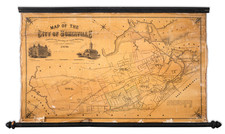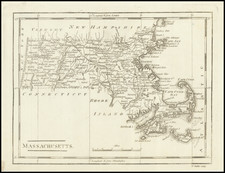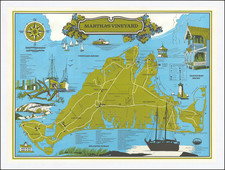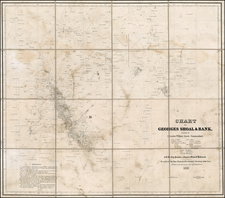Early blueprint of Henry Coffin's mapping of Trott Hills, laid out in 1821.
As a means of dividing up some of Nantucket's jointly owned lands, in 1821, several areas were designated as dividend lands, intended to be distributed among the proprietors. Among these areas were Trotts Hills, Head of Plains, Smooth Hummocks, and others. This term "dividend lands" suggests that these areas were probably considered as a form of profit or return from the collective property owned by the proprietors.
The establishment of English settlement on Nantucket in the mid-17th century followed a model similar to many New England colonies, initiated by a group of share-holding investors forming a closed corporation. Unique to Nantucket, however, was the persistence of this proprietorship as a distinct, parallel governing entity, operating independently alongside the Town Meeting well beyond its initial temporary intention.
The origins of this proprietorship trace back to a group commonly referred to as the "Proprietors," distinct from Ralph Waldo Emerson's reference to the island’s Wampanoags as “ancient proprietors.” The English settlement's foundational group comprised ten men: Tristram Coffin Sr., Peter Coffin, Thomas Macy, Richard Swain, John Swain, Thomas Barnard, Christopher Hussey, Stephen Greenleaf, William Pile, and Thomas Mayhew of Martha’s Vineyard. These individuals were the initial investors and were later joined by partners who became full shareholders, establishing an egalitarian base for the venture. These partners included Tristram Coffin Jr., James Coffin, John Smith, Robert Pike, Thomas Look, Robert Barnard, Edward Starbuck, Thomas Coleman, John Bishop, and Thomas Mayhew Jr., whose descendants would carry on the legacy of the Proprietors.
The "first purchasers" secured the rights to Nantucket from potential claimants—Sir Fernando Gorges, the Earl of Stirling, and Thomas Mayhew Sr.—the latter retaining a portion of interest for himself. The initial acquisition not only involved financial transactions but also agreements with the local Wampanoag groups. The Proprietors compensated the Wampanoags for portions of the land and obtained grazing rights across the island, laying the groundwork for the English settlement and governance that would follow.
This complex arrangement of purchase, partnership, and governance set the stage for Nantucket's development, distinguishing its proprietorship model from other colonial enterprises. The enduring structure of this body, beyond its original scope, highlights a unique facet of Nantucket's historical and governance landscape.
Blueprint & Blue Line maps (Cyanotype Printing)
Blueprint and blue line maps were among the most popular means for the swift printing of maps for which there would be a limited demand. A blueprint or blue line map could be made and/or revised much more quickly than a lithograph, cerograph, or other printing method, and at a much lower cost.
This method of printing was invented in 1842 by John Herschel, a chemist, astronomer, and photographer. A cyanotype process, one starts by drawing on semi-transparent paper, weighted down by a top sheet of paper. The paper would be coated with a photosensitive chemical mixture of potassium ferricyanogen and ferric ammonium citrate. The paper would then be exposed to light, wherein the exposed portions turned blue and the drawn lines, protected from exposure, would remain white.
The cyanotype printing process was an improvement on the expensive and time-consuming method of hand-tracing original documents. The technique was particularly popular with architects; by the 1890s, a blueprint was one-tenth the cost of a hand-traced reproduction. It could also be copied more quickly.
Blueprint and blue line maps began to appear as early as the 1850s and 1860s, but they really began to become the standard for mining and similar limited-purpose maps by the 1880s. The ability to create these maps quickly and at a low cost made them the standard for short-run prints, ideal for mapping mining regions in the West and for similar purposes.
The method still exists today, but in a very limited fashion. In the 1940s, diazo prints (whiteprints or bluelines) became more popular, as they were easier to read and faster to make. The blue lines on a white background of these prints are now what most people call blueprints.












![[Massachusetts Bay, with Boston and Part of Cape Cod]](https://storage.googleapis.com/raremaps/img/small/59282.jpg)
![[Special Promotional / Sample Map for Rand McNally Business Atlas] Massachusetts](https://storage.googleapis.com/raremaps/img/small/89042.jpg)
